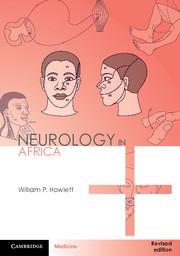Book contents
- Frontmatter
- Dedication
- Contents
- PREFACE
- Acknowledgments
- Part II Neurological Disorders
- 3 Public Health
- 4 Epilepsy
- 5 Stroke
- 6 Neurological Infections
- 7 Protozoal Andhelminthic Infections
- 8 Neurological Illness in HIV Disease
- 9 Coma and Transient Loss of Consciousness
- 10 Paraplegia Non Traumatic
- 11 Disorders of Peripheral Nerves
- 12 Cranial Nerve Disorders
- 13 Myopathies and Myasthenia Gravis
- 14 Movement Disorders and Motor Neurone Disease
- 15 Headache and Facial Pain
- 16 Intracranial Tumours
- 17 Dementia
- 18 Inherited Neurological Disorders
- 19 Head and Spinal Injury
- 20 Care in Neurology
- INDEX
- ABBREVIATIONS
- USEFUL WEBSITES
15 - Headache and Facial Pain
from Part II - Neurological Disorders
- Frontmatter
- Dedication
- Contents
- PREFACE
- Acknowledgments
- Part II Neurological Disorders
- 3 Public Health
- 4 Epilepsy
- 5 Stroke
- 6 Neurological Infections
- 7 Protozoal Andhelminthic Infections
- 8 Neurological Illness in HIV Disease
- 9 Coma and Transient Loss of Consciousness
- 10 Paraplegia Non Traumatic
- 11 Disorders of Peripheral Nerves
- 12 Cranial Nerve Disorders
- 13 Myopathies and Myasthenia Gravis
- 14 Movement Disorders and Motor Neurone Disease
- 15 Headache and Facial Pain
- 16 Intracranial Tumours
- 17 Dementia
- 18 Inherited Neurological Disorders
- 19 Head and Spinal Injury
- 20 Care in Neurology
- INDEX
- ABBREVIATIONS
- USEFUL WEBSITES
Summary
Headache is a very common problem which affects most persons at some point during their lives. The vast majority are due to tension headache, migraine and analgesic overuse. These are termed primary headaches and are mostly benign, but for some they are very debilitating disorders. The diagnosis of primary headache is made entirely from the history as there are no abnormal signs or investigations. A much smaller group consists of secondary or medically serious headaches. These headaches are caused by an underlying disease or disorder. This group includes infections, space occupying lesions, intracranial haemorrhage and usually have signs and abnormal investigations. It is important to separate these two groups clinically as they obviously have different implications for the patient. This chapter reviews the main headache disorders and facial pain and their investigation and treatment. After reading it the student should aim to be able to recognise and distinguish the medically serious headaches and the main primary headache disorders and also facial pain.
Pain
The brain itself is a painless organ. The source of the pain in headache arises from the structures overlying the brain; these include the scalp, skull, meninges and blood vessels. The dura and blood vessels are the most pain sensitive structures in the head. The site of the headache may sometimes be a guide to the origin of the headache. In general pain arising from the anterior and middle cranial fossa is referred to the forehead and front of the head whereas pain arising in the posterior fossa and upper cervical area is referred to the back of the head and neck. Pain arising from the surface of the brain tends to be diffuse, “all over” or occipital or nuchal as in meningitis or spread more focally over the overlying vertex or parietal and temporal areas as in tumours. Pain in the head may also be referred to the face, neck, ears, eyes, teeth and sinuses.
Classification
Headaches can be broadly classified into primary and secondary. The main causes are outlined below in Tables 15.1 & 15.4.
The history
A good history based on the temporal pattern of symptoms is essential in determining the cause of headache. This will include the time course, (onset, duration etc), site, severity, pattern and factors which alter or affect it.
- Type
- Chapter
- Information
- Neurology in AfricaClinical Skills and Neurological Disorders, pp. 349 - 364Publisher: Cambridge University PressPrint publication year: 2015



